Lighter, and as strong as steel, but much more durable, glass-fibre-reinforced (GRP) pipes can extend up to 4 m in diameter for applications that include major desalination projects and standard high-pressure bulk water supply. So, Flowtite™ GRP is far from fragile. The end benefit: over 150 years of virtually zero maintenance.
FlowtiteTM GRP pipe has been a household engineering brand since the introduction of this pioneering Norwegian technology in the 1960s. Owned by the multinational Amiantit Group since 2001, it’s a preferred choice for municipal infrastructure and general industrial users worldwide, with more than 70 000 km of FlowtiteTM GRP installed to date. That’s supported by proven research, which shows a minimal record of leakage failures, and amazing durability and resistance to corrosion and chemical attack on original installations done more than 50 years ago. Samples taken show no visible change or deterioration over this period. Local manufacturing licensee Flowtite South Africa was appointed by the Flowtite Group in 2018 to spearhead domestic and broader sub-Saharan expansion, backed by funding from the Industrial Development Corporation. Investment in manufacturing is a major government objective and, in this respect, Flowtite is a 100% local content producer in line with Department of Trade and Industry guidelines and meets all SOE and municipal procurement stipulations. Gearing up for growth, Flowtite is currently embarking on a R150+ million upgrade of its Germiston, Gauteng, factory. Integral to that strategy is a concerted communication drive to inform private and public procurement decision-makers about FlowtiteTM GRP benefits compared to alternative pipe systems made from steel, concrete or plastic. Key advantages of FlowtiteTM GRP include its ability to produce legendary strength with low material mass, making it easy to manipulate by hand or install with light construction equipment. “In key markets like Europe and North America, FlowtiteTM GRP is a common application, and engineering students are exposed to and well informed about this technology during their studies. That’s alongside other conventional pipe alternatives,” explains Bantu Mselana, managing director, Flowtite South Africa. “That’s not the case for South African students. “Although FlowtiteTM GRP has been part of the South African construction mix from 1992, the evidence of FlowtiteTM GRP projects has been intermittent because of a widespread gap in both the understanding and application of the technology. So, it’s understandable that many South African engineers will have had limited exposure, despite FlowtiteTM GRP’s universal specification on water and sewer projects internationally,” he continues. “We are here to change that and to reinforce the major benefits of FlowtiteTM GRP as a cost-effective and virtually maintenance-free infrastructure solution.”Market engagement
Flowtite South Africa is listening to the views and perceptions of the market, experienced engineers, contractors and other stakeholders in the public and private sphere, some of whom may have misconceptions about FlowtiteTM GRP, largely due to the absence of a single consistent brand owner and manufacturer, until now.FlowtiteTM GRP has over 70 000 km of pipe installed worldwide in applications including bulk water supply, hydropower, seawater desalination, sewer networks, reticulation networks, irrigation water supply and many others, where the pressures range from PN 1 to PN 32. In South Africa specifically, more than 2 500 km of Flowtite pipes are installed and in active service. With 24 manufacturing plants across the globe, FlowtiteTM GRP pipe is increasingly becoming the technology of choice for many clients because of its hybrid characteristics that address the concerns experienced with other homogeneous piping materials.
As part of its repositioning of the technology in the local market, Flowtite South Africa will focus on expanding its cradle-to-grave services to ensure that its clients obtain maximum benefit from the use of its technology, as well as introducing new product lines that will offer superior value for its customers. Over the past 30 years, FlowtiteTM GRP pipes have enjoyed significant growth, becoming an integral part of the infrastructure mix in South Africa. But key to sustaining this growth is ensuring quality, visibility, customer service, support and value for money. These are the areas that Flowtite South Africa is making significant strides in to achieve market growth.







